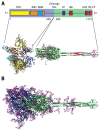Phage-Displayed Mimotopes of SARS-CoV-2 Spike Protein Targeted to Authentic and Alternative Cellular Receptors
- PMID: 35215976
- PMCID: PMC8879608
- DOI: 10.3390/v14020384
Phage-Displayed Mimotopes of SARS-CoV-2 Spike Protein Targeted to Authentic and Alternative Cellular Receptors
Abstract
The evolution of the SARS-CoV-2 virus during the COVID-19 pandemic was accompanied by the emergence of new heavily mutated viral variants with increased infectivity and/or resistance to detection by the human immune system. To respond to the urgent need for advanced methods and materials to empower a better understanding of the mechanisms of virus's adaptation to human host cells and to the immuno-resistant human population, we suggested using recombinant filamentous bacteriophages, displaying on their surface foreign peptides termed "mimotopes", which mimic the structure of viral receptor-binding sites on the viral spike protein and can serve as molecular probes in the evaluation of molecular mechanisms of virus infectivity. In opposition to spike-binding antibodies that are commonly used in studying the interaction of the ACE2 receptor with SARS-CoV-2 variants in vitro, phage spike mimotopes targeted to other cellular receptors would allow discovery of their role in viral infection in vivo using cell culture, tissue, organs, or the whole organism. Phage mimotopes of the SARS-CoV-2 Spike S1 protein have been developed using a combination of phage display and molecular mimicry concepts, termed here "phage mimicry", supported by bioinformatics methods. The key elements of the phage mimicry concept include: (1) preparation of a collection of p8-type (landscape) phages, which interact with authentic active receptors of live human cells, presumably mimicking the binding interactions of human coronaviruses such as SARS-CoV-2 and its variants; (2) discovery of closely related amino acid clusters with similar 3D structural motifs on the surface of natural ligands (FGF1 and NRP1), of the model receptor of interest FGFR and the S1 spike protein; and (3) an ELISA analysis of the interaction between candidate phage mimotopes with FGFR3 (a potential alternative receptor) in comparison with ACE2 (the authentic receptor).
Keywords: SARS-CoV-2 virus; alternative receptors; landscape phage; mimotope; molecular mimicry; phage display; spike protein; virus receptors.
Conflict of interest statement
The authors declare no competing financial interest.
Figures












Similar articles
-
Natural and Recombinant SARS-CoV-2 Isolates Rapidly Evolve In Vitro to Higher Infectivity through More Efficient Binding to Heparan Sulfate and Reduced S1/S2 Cleavage.J Virol. 2021 Oct 13;95(21):e0135721. doi: 10.1128/JVI.01357-21. Epub 2021 Aug 18. J Virol. 2021. PMID: 34406867 Free PMC article.
-
Comprehensive characterization of the antibody responses to SARS-CoV-2 Spike protein finds additional vaccine-induced epitopes beyond those for mild infection.Elife. 2022 Jan 24;11:e73490. doi: 10.7554/eLife.73490. Elife. 2022. PMID: 35072628 Free PMC article.
-
Uncovering the impact of SARS-CoV2 spike protein variants on human receptors: A molecular dynamics docking and simulation approach.J Infect Public Health. 2023 Oct;16(10):1544-1555. doi: 10.1016/j.jiph.2023.07.011. Epub 2023 Jul 24. J Infect Public Health. 2023. PMID: 37566991
-
Angiotensin-Converting Enzyme 2 (ACE2) in the Pathogenesis of ARDS in COVID-19.Front Immunol. 2021 Dec 22;12:732690. doi: 10.3389/fimmu.2021.732690. eCollection 2021. Front Immunol. 2021. PMID: 35003058 Free PMC article. Review.
-
The expression of hACE2 receptor protein and its involvement in SARS-CoV-2 entry, pathogenesis, and its application as potential therapeutic target.Tumour Biol. 2021;43(1):177-196. doi: 10.3233/TUB-200084. Tumour Biol. 2021. PMID: 34420993 Review.
Cited by
-
Phage Display's Prospects for Early Diagnosis of Prostate Cancer.Viruses. 2024 Feb 10;16(2):277. doi: 10.3390/v16020277. Viruses. 2024. PMID: 38400052 Free PMC article. Review.
-
The Ambivalence of Post COVID-19 Vaccination Responses in Humans.Biomolecules. 2024 Oct 17;14(10):1320. doi: 10.3390/biom14101320. Biomolecules. 2024. PMID: 39456253 Free PMC article. Review.
-
Quantitative Mutation Analysis of Genes and Proteins of Major SARS-CoV-2 Variants of Concern and Interest.Viruses. 2023 May 18;15(5):1193. doi: 10.3390/v15051193. Viruses. 2023. PMID: 37243278 Free PMC article.
-
A Novel Serum-Based Diagnosis of Alzheimer's Disease Using an Advanced Phage-Based Biochip.Adv Sci (Weinh). 2023 Jul;10(21):e2301650. doi: 10.1002/advs.202301650. Epub 2023 May 7. Adv Sci (Weinh). 2023. PMID: 37150869 Free PMC article.
-
Construction, Characterization, and Application of a Nonpathogenic Virus-like Model for SARS-CoV-2 Nucleocapsid Protein by Phage Display.Toxins (Basel). 2022 Oct 4;14(10):683. doi: 10.3390/toxins14100683. Toxins (Basel). 2022. PMID: 36287952 Free PMC article.
References
Publication types
MeSH terms
Substances
Supplementary concepts
Grants and funding
LinkOut - more resources
Full Text Sources
Other Literature Sources
Miscellaneous

